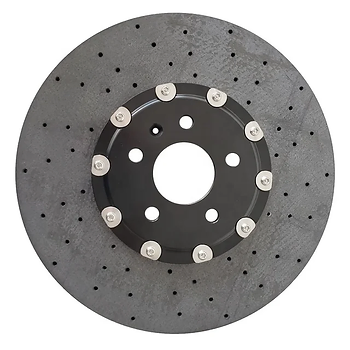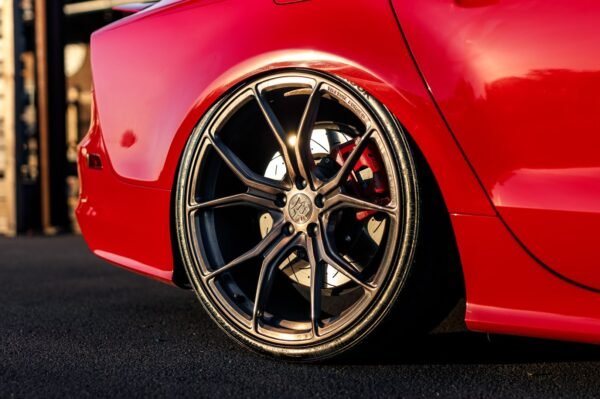Carbon ceramic matrix brake discs are a high-performance alternative to traditional iron or steel brake discs. They are commonly used in high-performance sports cars, race cars, and even in some military and aerospace applications. In this article, we’ll take a closer look at what carbon ceramic matrix brake discs are, how they work, and why they are becoming more popular in the automotive industry.
What Are Carbon Ceramic Brake Discs?

Carbon ceramic brake discs, often seen gracing the wheels of high-performance vehicles and supercars, are marvels in the world of automotive engineering. Crafted through a sophisticated process that combines carbon fibers with silicon to form a material that is not just lightweight but incredibly tough, these braking components redefine efficiency and durability. What sets them apart isn’t just their ability to endure extreme stress without warping like conventional steel discs can but also their exceptional heat dissipation qualities. This means a significant reduction in brake fade even under the most demanding conditions, ensuring consistent performance from your first lap to your last.
But here’s where it gets really interesting: unlike standard metal brakes, carbon ceramic discs offer an unparalleled lifespan, oftentimes outlasting the car itself! This attribute alone presents a fresh perspective on value – what might appear as an upscale investment upfront actually emerges as cost-efficient over time due to its longevity and reduced wear on related parts like brake pads. Moreover, they contribute to enhanced fuel economy by reducing overall vehicle weight; thus embracing carbon ceramic technology doesn’t just elevate performance but also nudges us towards sustainable driving practices.
How are Carbon Ceramic Brakes Different from Traditional Metal Brakes?
Carbon ceramic brake discs, often referred to as carbon-ceramic brakes (CCBs), offer several advantages over traditional metal brakes, such as cast iron or steel discs. Here are some properties that differentiate carbon ceramic brake discs:
High Temperature Resistance: Carbon ceramic brake discs can withstand much higher temperatures compared to traditional metal brakes. This property helps prevent brake fade during intense braking situations, such as track driving or mountain descents.
Lightweight: Carbon ceramic brake discs are significantly lighter than their metal counterparts. This reduction in unsprung weight contributes to improved handling, better suspension response, and overall vehicle performance.
Low Wear Rate: Carbon ceramic brake discs have a lower wear rate compared to metal brakes. This results in longer service intervals and reduced maintenance costs over the lifetime of the brakes.
Corrosion Resistance: Carbon ceramic brake discs are highly resistant to corrosion, which prolongs their lifespan and ensures consistent braking performance even in harsh environmental conditions.
Reduced Brake Dust: Carbon ceramic brake discs produce minimal brake dust compared to traditional metal brakes. This property helps in keeping the wheels cleaner, reducing maintenance efforts, and preserving the aesthetic appeal of the vehicle.
Improved Fade Resistance: Carbon ceramic brake discs exhibit superior fade resistance, maintaining consistent braking performance even under repeated heavy braking. This is particularly advantageous in high-performance driving scenarios.
Enhanced Performance: Carbon ceramic matrix brake discs have a much higher coefficient of friction than traditional iron or steel brake discs, which means they can generate more stopping power with less pressure on the brake pedal. Due to their ability to handle high temperatures and maintain consistent performance, carbon ceramic brake discs contribute to improved braking efficiency, shorter stopping distances, and better overall vehicle control.
Longevity: While carbon ceramic brake discs typically have a higher initial cost than traditional metal brakes, their longevity and reduced maintenance requirements can result in cost savings over the long term, especially for performance-oriented or high-mileage vehicles.
Cost Considerations: Initial Investment vs Long Term Savings
The cost considerations of carbon ceramic brakes involve evaluating the initial investment compared to the long-term savings over the lifespan of the brakes. Here’s a breakdown of the cost factors to consider:
Initial Investment:
Carbon ceramic brake systems typically have a higher initial cost compared to traditional metal brakes. The cost difference can be substantial, potentially adding thousands of dollars to the vehicle’s purchase price or aftermarket upgrade cost.
Long-Term Savings:
Reduced Maintenance: Carbon ceramic brake discs have a lower wear rate compared to traditional metal brakes, leading to longer service intervals and reduced maintenance costs over time. With less frequent replacements, owners save on labor and parts costs associated with brake maintenance.
Longer Lifespan: Carbon ceramic brake discs are highly durable and resistant to corrosion, contributing to a longer lifespan compared to traditional metal brakes. This longevity can further reduce the need for replacements, providing additional savings over the vehicle’s lifetime.
Performance Benefits: Carbon ceramic brakes offer superior performance, including better fade resistance, improved braking efficiency, and shorter stopping distances. While not directly translating to monetary savings, these performance benefits may contribute to enhanced safety and driving enjoyment, which could be valuable to some consumers.
Reduced Brake Dust: Carbon ceramic brake discs produce minimal brake dust compared to traditional metal brakes. This reduces the frequency of wheel cleaning and maintenance, potentially saving time and effort for vehicle owners.
Total Cost of Ownership (TCO):
When considering the total cost of ownership, it’s essential to factor in both the initial investment and the long-term savings associated with carbon ceramic brakes. While the upfront cost may be higher, the potential savings from reduced maintenance and longer lifespan can offset this initial expense over time.
TCO analysis should also consider other factors such as vehicle depreciation, resale value, driving habits, and environmental considerations to provide a comprehensive evaluation of the cost-effectiveness of carbon ceramic brakes.
In summary, while carbon ceramic brakes may have a higher initial investment compared to traditional metal brakes, their long-term savings potential, including reduced maintenance costs and longer lifespan, can make them a cost-effective option for certain applications, particularly in high-performance or luxury vehicles where performance and durability are prioritized.
Maintenance and Longevity of Carbon Ceramic Brakes: What To Expect?
Maintenance:
Carbon ceramic brakes generally require less maintenance compared to traditional metal brakes due to their lower wear rate and resistance to corrosion.
Routine Inspections: Regular visual inspections of the brake components are recommended to check for any signs of damage, wear, or deterioration. This includes inspecting the brake discs, pads, calipers, and brake lines.
Brake Fluid: While carbon ceramic brake discs themselves are highly resistant to corrosion, it’s essential to maintain the quality of the brake fluid. Periodic brake fluid flushes according to the manufacturer’s recommendations help ensure optimal braking performance and protect the brake system from internal corrosion.
Longevity:
Carbon ceramic brake discs are known for their exceptional longevity compared to traditional metal brakes.
Wear Rate: Carbon ceramic brake discs typically have a much lower wear rate, meaning they can last significantly longer before requiring replacement. The exact lifespan can vary depending on factors such as driving conditions, driving style, vehicle weight, and maintenance practices.
Track Use: Carbon ceramic brakes are commonly used in high-performance and racing applications due to their superior heat resistance and fade resistance. While aggressive driving on the track can accelerate wear, carbon ceramic brakes generally hold up well under extreme conditions compared to metal brakes.
Environmental Factors: Carbon ceramic brakes are highly resistant to corrosion, making them well-suited for use in harsh environmental conditions, including wet or salty road conditions.
Replacement:
Eventually, even carbon ceramic brake discs will wear out and require replacement, although this occurs less frequently compared to traditional metal brakes.
Replacement Cost: The cost of replacing carbon ceramic brake discs and pads is typically higher than that of traditional metal brakes due to the specialized materials and manufacturing processes involved.
Service Life: The service life of carbon ceramic brake discs can vary depending on driving habits, vehicle usage, and maintenance practices. However, they are designed to last significantly longer than traditional metal brakes, potentially extending the interval between replacements to tens of thousands of miles or more.
Overall, carbon ceramic brakes offer superior longevity and reduced maintenance requirements compared to traditional metal brakes, making them an attractive option for high-performance vehicles and applications where durability and performance are paramount. Proper maintenance and periodic inspections are essential to ensure optimal performance and longevity of carbon ceramic brake systems.
Conclusion
Carbon ceramic brake discs are a high-performance alternative to traditional iron or steel brake discs. They offer better performance, are lighter, and have a longer lifespan, making them an ideal choice for high-performance vehicles. As the automotive industry continues to evolve, it’s likely that we’ll see more and more vehicles equipped with carbon ceramic matrix brake discs in the future.


